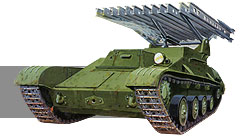


- adler
Countries
| 38.3% |  | Russia |
| 13.1% |  | USA |
| 10.5% |  | Ukraine |
| 6% |  | Germany |
| 4.5% |  | Poland |
Visitors
| Today: | 485 |
| Yesterday: | 1785 |
| This Week: | 7898 |
| Last Week: | 12992 |
| This Month: | 34862 |
| Last Month: | 30673 |
| Total: | 83104 |
T-50 Light Support Tank |
 |
 |
Created Tuesday, 20 September 2005 18:57
|
|||
Last Updated on Monday, 28 September 2009 08:32
|
|||
|
Despite the development of the formidable T-34, the idea of a new In 1939, the Kirovsky factory was ordered to develop a light CS tank (close support tank). In The new tank did have the 45mm Tank Gun Model 1932/38 supplied with The tank had torsion bar suspension. Its chassis consisted of six steel road wheels (each with internal shock absorber), idler, rear driver wheel with removable cogged rim, and three support wheels. The transmission consisted of the Measured by aggregate armament and protection, «Object 126» was superior to most of the Soviet light and medium tanks of that time. In fact, the German The second prototype received new lighter road wheels with rubber tires. Simultaneously, at In their construction the T-50 and the «Object 126» were quite similar. Like its prototype, the T-50 had The T-50 had the torsion bar suspension with road wheels with internal shock absorbers. The tank was powered by On those times point of view, the T-50 was intended to be a kind of «universal» tank and should replace T-26 and BT Here At that time, an artillery testings congucted at NII-48 Research Lab. These tests proved the T-50 couldn't be penetrated by the Soviet 76 mm Gun Model 1939 at In April 1941, the T-50 was accepted for service. Until the beginning of the Great Patriotic War, factory #174 produced not a single T-50, however. The most serious problem was with V-4 engine that was in fact very unreliable and expensive. Till the end of war, Soviet industry was unable to build an efficient and reliable V-4. Through extreme efforts Soviet industry was able to produce In August 1941, the Factory #174 was evacuated: mostly in Omsk, but several parts in Nizhnij Tagil and Barnaul. On October 13, 1941, the History has left few combat records of this very interesting tank. The T-50 was adequately protected, its armor protection was almost equal to T-34. Tank was intended to rearm with 57mm ZIS-4 Tank Gun. Its speed and maneuverability was much better then T-34. Also, the commander's cupola and restricted duties of the tank commander were also important improvement (comparing to the T-34). The steel intensity of the T-34 was twice as much then T-50. So why the production of such advanced tank was ceased? In fact, there were three reasons. At first, the mass production was tried to set up after the beginning of the Great Patriotic War. At second, from autumn 1941, the Red Army began to receive British and Canadian «Valentine» tanks, which were quite close to the T-50 (with exception to maneuverability). At third, there were no available factory ready to produce V-4 engines. That's why the fate of the T-50 was so short. Only Important to mention there were two types of T-50 distinguished by different armor thickness: the first one was It's important to mention another variant of T-50: the «Object 211», which was developed by After the beginning of the Great Patriotic War, all further works on this project were cancelled. The single «Object 211» was used in defense of Leningrad and its further fate is
|
You need to login or register to post comments.
Discuss this item on the forums. (0 posts)
© THE RUSSIAN BATTLEFIELD, 1998-2009



 LKZ
LKZ












